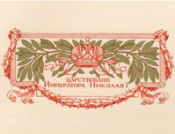
The Presidential library: New acquisitions
To the 220th anniversary of the Russian Emperor Nicholas I the collection Romanov dynasty. Zemsky Sobor in 1613 (section Romanovs at the end of XVIII - the beginning of XX century) has been enriched with materials from the State Public Historical Library, the Russian State Historical Archive, the Russian State Library, the Russian Institute of History of Art, the Library of the Moscow Theological Academy, Children's Museum of postcard.
In the book of M. A. Polievktov Nicholas I: Background and Overview of the reign (Moscow, 1918) Emperor Government activity through the prism of the personal life of Nicholas, his views and interests. It is used historical documents of the time (acts, collections of documents and papers, letters to the Emperor Nicholas I, and submitted the note to him, the documents relating to the Kingdom of Poland and the uprising of 1830-1831; own scrapbook of Emperor Nicholas I, his correspondence, speech given them instructions and so on).
The work of the historian Alexander Yevgeniyevich Presnyakov Apogee of autocracy. Nicholas I (L., 1925) is devoted to the history of the Russian emperor's reign of Nicholas I (1796-1855). The publication describes the personal and official life of the emperor, his methods of governance, given the reviews of contemporaries.
Sergei Spiridonovich Tatishchev dedicated his work Emperor Nicholas and foreign yards (St. P., 1889) to the foreign policy of the Russian state during the reign of Nicholas I. Particular attention is given to the author's personal relation to sovereign foreign courts (England, Austria, France, Prussia). The application includes essay "The Emperor William I of Russia".
The grandson of Nicholas I, Grand Duke Nicholas Mikhailovich in the study Execution of five Decembrists July 13, 1826 and the Emperor Nicholas I (Pg. 1916) draws the reader's attention to the sentence imposed on 11 (23) July 1826 by the High Criminal Court in the case of five of the Decembrists set out bits (P. I. Pestel, K. F. Rileyev, S. I. Muravyov-Apostol, M. P. Bestuzhev-Ryumin and P. G. Kakhovsky).
Art historian, art critic, art exhibitions organizer Nikolai Nikolayevich Wrangel in the book Art and the Emperor Nicholas Pavlovich (Pg., 1915) gives an estimate of the Emperor of activity in the arts, both positive and negative sides. The publication is equipped with 12 sheets of illustrations on separate inserts with 23 phototypes.
The fourth volume (St. P., 1911) of the fundamental work "Grand duke, royal and imperial hunting in Russia" (1896-1911) by the famous historian, Major General, head of the economic part of the Imperial hunting Nikolay Ivanovich Kutepov is devoted to the imperial hunting in Russia in the late XVIII and XIX at. At the end of the XIX century, at the suggestion of the Emperor Alexander III Kutepov started research and produced a series of books on hunting in Russia for the entire historical period of its existence. The work on the book known to have been used at the time the documents for hunting stories from Russian archives and libraries. For an illustration of this work was to attract the best Russian artists of the late XIX - early XX century: L. S. Bakst, A. K. Beggrov, A. N. Benois, A. M. Vasnetsov, E. E. Lancer, K. V. Lebedev, A. P. Ryabushkin, I. E. Repin, V. I. Surikov, F. A. Rubo, L. O. Pasternak, K. A. Savitsky, V. A. Serov, A. S. Stepanov. There were used lithogpahs and works by G. Doe, B. G. Schwarz, F. G. Solntsev, A. D. Litovchenko. Making the entire publication as a whole was assigned to the N. S. Samokisha. In the notes to the texts of the volumes of authentic historical documents: the works of Russian historians, notes of foreign travelers, chronicles and documentary evidence, literary works, excerpts from diaries kings hunting and much more. The multi-volume publication describes the development of hunting, about the details of canine and falconry on the hunting way of life, equipment, beliefs and bitter about the species of dogs and horses, hunting areas, the composition of the officials and servants of the royal hunt, about everyday and political significance.
Drama in 5 acts by G. Panyurin Emperor Nicholas I (Berlin, [1908]) highlights the life and work of the Emperor from the moment of his arrival to power in the day of the uprising of the Decembrists, and ending with his death in the midst of failure for Russia the Crimean campaign.
The reproduction of the open letter depicts a picture of the famous French painter Horace Vernet "Tsarskoye Selo carousel", commissioned by Emperor Nicholas I. In a painting is embodied bright colorful spectacle, diffused in almost all European courts - the medieval carousel - type of equestrian competition that replaced the joust. The carousel "knights" were moving around and gallop performed a series of exercises. The painting depicts a courtly cavalcade, consisting of members of the emperor's family, dressed in authentic medieval armor of the Emperor's personal collection. The feast was prepared in connection with the 25th anniversary of the wedding of Prince Nicholas and the Prussian Princess Friederike Louise-Charlotte Wilhelmina.
It is presented Memories of the infant years of Emperor Nicholas, written in his own hand (St. P., 1906). The text is carried out in parallel on the Russian and French.
The preparation of new materials for the collection will be continued.

